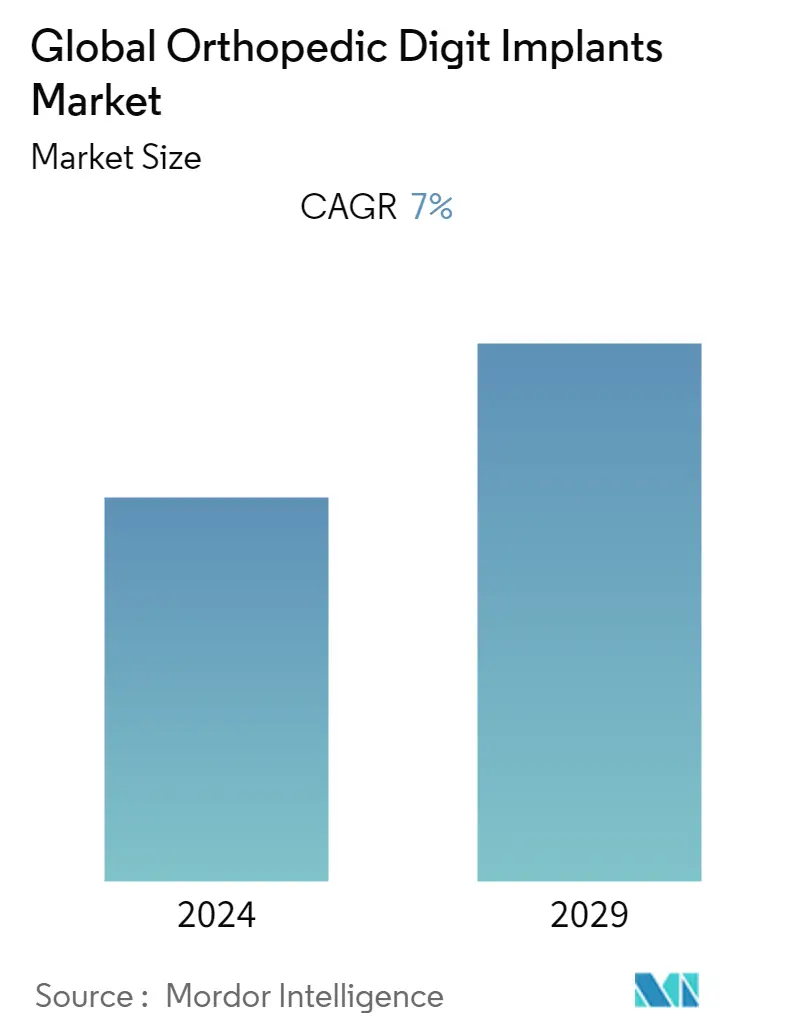Market Size of Global Orthopedic Digit Implants Industry

| Study Period | 2019 - 2029 |
| Base Year For Estimation | 2023 |
| Forecast Data Period | 2024 - 2029 |
| CAGR | 7.00 % |
| Fastest Growing Market | North America |
| Largest Market | Asia Pacific |
Major Players
*Disclaimer: Major Players sorted in no particular order |
Orthopedic Digit Implants Market Analysis
The orthopedic digit implants market is expected to register a CAGR of 7% over the forecast period.
The COVID-19 epidemic had a profound effect on the market initially. For instance, according to an article published by PubMed in August 2021, a study was conducted in Chile which showed that there was a 22.8% decline in the number of orthopedic surgeries during the pandemic. With the decline of orthopedic surgeries, digital bone implant surgeries have also fallen during the pandemic. However, as the pandemic has subsided currently, orthopedic surgeries are expected to take place normally around the world, which will lead to stable growth of the studied market.
The increasing geriatric population worldwide and the rise of arthritis are the mainstays of the orthopedic digit implants market. In addition, growing awareness about less intrusive technology and the advent of 3D printing technology has revolutionized the use of orthopedic technology. This is expected to have a positive impact on market growth in the forecast period. According to the data updated by NCBI in May 2022, it is estimated that osteoarthritis affects about 3.3 to 3.6% of the population globally and it causes moderate to severe disability in 43 million people, making it the 11th most debilitating disease worldwide. The article also stated that in the United States, it is estimated that 80% of the population over 65 years old has radiographic evidence of osteoarthritis, although only 60% of this subset has symptoms. The growing prevalence of arthritis and the increasing burden of arthritis conditions among the elderly are expected to boost market growth.
Furthermore, according to the World Population Prospects: 2022 published by the UN in 2022, it is estimated that the share of the global population aged 65 years or above is projected to rise from 10% in 2022 to 16% in 2050. It is also estimated that by 2050, the number of persons aged 65 years or over worldwide is projected to be more than twice the number of children under age 5 and about the same as the number of children under age 12. As a person grows older, his bones become weaker, which makes him more prone to fractures. Thus, all of the above statistics indicate that the world's population is ageing, which is expected to enhance the future market growth.
Additionally, the launch of new products in the market will also boost the studied market growth. For instance, in August 2021, the Orthopedic Implant Company launched wrist fracture plating technology, called the DRPx System with an enhanced ergonomic design to meet the technique preferences of orthopedic surgeons.
Hence, due to the abovementioned factors such as the increasing prevalence of arthritis, the rising geriatric population, and new product launches, the studied market is expected to experience growth. However, the stringent regulatory procedures and post-surgery infections and low adaptation of implants are expected to hamper market growth over the forecast period.
Orthopedic Digit Implants Industry Segmentation
As per the scope of the report, orthopedic digit implants are the medical devices used to replace damaged or injured small bones or joint segments such as the toe, elbow, ankle, knee, and others. Orthopedic digits are biocompatible and made up of titanium or stainless steel, and they function as artificial bones. The market is segmented by product type (metatarsal joint implants, metacarpal joint implants, toe intramedullary digit implants, scaphoid bone digit implants, and hemi phalangeal digit implants), material (pyrocarbon, titanium, nitinol, and other materials), end user (hospitals and specialty orthopedic clinics), and geography (North America, Europe, Asia-Pacific, Middle East and Africa, and South America). The market report also covers the estimated market sizes and trends for 17 different countries across major regions, globally. The report offers the value (in USD million) for the above-mentioned segments.
| By Product Type | |
| Meta Tarsal Joint Implants | |
| Meta Carpal Joint Implants | |
| Toe Intramedullary Digit Implants | |
| Scophoid Bone Digit Implants | |
| Hemiphalangeal Digit Implants |
| By Material | |
| Pyrocarbon | |
| Titanium | |
| Nitinol | |
| Other Materials |
| By End User | |
| Hospitals | |
| Speciality Orthopedic Clinics |
| Geography | ||||||||
| ||||||||
| ||||||||
| ||||||||
| ||||||||
|
Global Orthopedic Digit Implants Market Size Summary
The orthopedic digit implants market is poised for significant growth, driven by the increasing geriatric population and the rising prevalence of arthritis globally. The market experienced a temporary setback during the COVID-19 pandemic due to a decline in orthopedic surgeries; however, it is expected to recover as surgical procedures normalize. The adoption of less intrusive technologies and advancements such as 3D printing have further revolutionized orthopedic practices, contributing positively to market expansion. The growing awareness and demand for innovative solutions, alongside the introduction of new products like the DRPx System and Accu-Joint program, are anticipated to bolster market growth. Despite challenges such as stringent regulatory procedures and the risk of post-surgery infections, the market is expected to thrive, particularly with the increasing incidence of bone fractures and the need for effective treatment options.
Regionally, North America is expected to witness substantial market growth, fueled by a high prevalence of osteoarthritis and a significant elderly population. The region's market is further strengthened by the presence of numerous market players and the continuous introduction of new products. The market's fragmentation is characterized by key players like Johnson & Johnson (DePuy Synthes), Smith & Nephew, and Stryker Corporation, who are actively engaging in geographic expansions and product development. Strategic acquisitions, such as CONMED Corporation's agreement to acquire In2Bones Global, Inc., highlight the ongoing efforts to enhance product portfolios and expand market reach. As the demand for digital orthopedic implants grows, the market is set to experience robust growth, driven by demographic trends and technological advancements.
Global Orthopedic Digit Implants Market Size - Table of Contents
-
1. MARKET DYNAMICS
-
1.1 Market Overview
-
1.2 Market Drivers
-
1.2.1 Increasing Geriatric Population and Rising Prevalence of Orthopedic Diseases
-
1.2.2 Increasing Preference of Minimally Invasive Surgeries and Advanced Products
-
-
1.3 Market Restraints
-
1.3.1 Stringent Regulatory Procedures
-
1.3.2 Post Surgery Infections and low Adaptation of Implants
-
-
1.4 Porter's Five Forces Analysis
-
1.4.1 Threat of New Entrants
-
1.4.2 Bargaining Power of Buyers/Consumers
-
1.4.3 Bargaining Power of Suppliers
-
1.4.4 Threat of Substitute Products
-
1.4.5 Intensity of Competitive Rivalry
-
-
-
2. MARKET SEGMENTATION (Market Size by Value - USD Million)
-
2.1 By Product Type
-
2.1.1 Meta Tarsal Joint Implants
-
2.1.2 Meta Carpal Joint Implants
-
2.1.3 Toe Intramedullary Digit Implants
-
2.1.4 Scophoid Bone Digit Implants
-
2.1.5 Hemiphalangeal Digit Implants
-
-
2.2 By Material
-
2.2.1 Pyrocarbon
-
2.2.2 Titanium
-
2.2.3 Nitinol
-
2.2.4 Other Materials
-
-
2.3 By End User
-
2.3.1 Hospitals
-
2.3.2 Speciality Orthopedic Clinics
-
-
2.4 Geography
-
2.4.1 North America
-
2.4.1.1 United States
-
2.4.1.2 Canada
-
2.4.1.3 Mexico
-
-
2.4.2 Europe
-
2.4.2.1 Germany
-
2.4.2.2 United Kingdom
-
2.4.2.3 France
-
2.4.2.4 Italy
-
2.4.2.5 Spain
-
2.4.2.6 Rest of Europe
-
-
2.4.3 Asia-Pacific
-
2.4.3.1 China
-
2.4.3.2 Japan
-
2.4.3.3 India
-
2.4.3.4 Australia
-
2.4.3.5 South Korea
-
2.4.3.6 Rest of Asia-Pacific
-
-
2.4.4 Middle East and Africa
-
2.4.4.1 GCC
-
2.4.4.2 South Africa
-
2.4.4.3 Rest of Middle East and Africa
-
-
2.4.5 South America
-
2.4.5.1 Brazil
-
2.4.5.2 Argentina
-
2.4.5.3 Rest of South America
-
-
-
Global Orthopedic Digit Implants Market Size FAQs
What is the current Global Orthopedic Digit Implants Market size?
The Global Orthopedic Digit Implants Market is projected to register a CAGR of 7% during the forecast period (2024-2029)
Who are the key players in Global Orthopedic Digit Implants Market?
Acumed LLC, Stryker Corporation, Smith & Nephew, Johnson & Johnson and Advin Health Care are the major companies operating in the Global Orthopedic Digit Implants Market.

